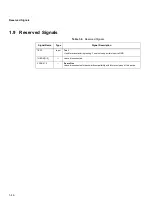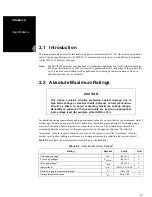
2-14
AC Timings
2.7.3.2 DMA Data Transfers
Table 2-17 describes the DMA signal timing.
The DREQ
signal is synchronized with the falling edge of
REFCLK
.
DONE
timing is relative to the rising
edge of
REFCLK
. To achieve fast response, a synchronized peripheral should assert
DREQ
according to
the timings in Table 2-17. Figure 2-7 shows synchronous peripheral interaction.
2.7.4 HDI16 Signals
Table 2-17. DMA Signals
Number
Characteristic Minimum
Maximum
Units
72
DREQ setup time before REFCLK falling edge
6
—
ns
73
DREQ hold time after REFCLK falling edge
0.5
—
ns
74
DONE setup time before REFCLK rising edge
9
—
ns
75
DONE hold time after REFCLK rising edge
0.5
—
ns
76
DACK/DRACK/DONE delay after REFCLK rising edge
0.5
9
ns
Figure 2-7. DMA Signals
Table 2-18. Host Interface (HDI16) Timing
1, 2
Number
Characteristics
3
Expression
Min
Max
Unit
44a
Read data strobe assertion width
4
HACK read assertion width
T
C
+ 3.3
6.6
—
ns
44b
Read data strobe deassertion width
4
HACK read deassertion width
T
C
+ 3.3
6.6
—
ns
44c
Read data strobe deassertion width
4
after “Last Data
Register” reads
5,6
, or between two consecutive CVR, ICR,
or ISR reads
7
HACK deassertion width after “Last Data Register” reads
5,6
(2.5
×
T
C
) + 3.3
11.6
—
ns
45
Write data strobe assertion width
8
HACK write assertion width
T
C
+ 3.3
6.6
—
ns
46
Write data strobe deassertion width
8
HACK write deassertion width after ICR, CVR and Data
Register writes
5
(2.5
×
T
C
) + 3.3
11.6
—
ns
REFCLK
DREQ
DONE Input
DACK/DONE/DRACK Outputs
73
72
74
75
76






























